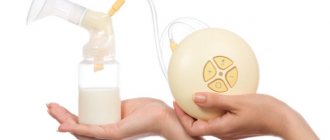During the fifth month of life, the baby’s daily routine remains almost the same as it was in the previous period. Only one thing changes - the baby becomes incredibly active, devoting all his waking hours to developing his motor skills.
Only after waking up from sleep do the kids begin to repeat the physical skills they learned the day before. Experts calculated how much a baby moves during the day and came to the conclusion that seemingly helpless infants experience enormous stress during periods of activity.
Most babies start teething at the age of four to five months, a process that is usually associated with severe pain that awakens them from sleep, and sometimes with an increase in body temperature. Because of this, babies may experience a slight shift in routine. As soon as the baby’s condition stabilizes, make every effort to return to the previous established regime.
What is the mode for?
The daily routine is extremely important for children of any age, because it:
- disciplines the baby;
- promotes the development of useful habits (for example, the baby remembers that he needs to do exercises in the morning and take a bath before bedtime);
- gives the baby calmness and confidence (he knows that he will certainly be fed, played with, etc.);
- strengthens the immune system (after all, the baby devotes enough time to sleep, walks, etc.);
- promotes further adaptation in society (it will be easier for the child to get comfortable in a preschool institution).
A clear daily routine is also important for parents, because a young mother will always be able to build her plans in accordance with it and include in them putting things in order, cooking, taking care of herself, meeting with a friend, etc. A child’s daily routine at 5 months must include should include: sleep, nutrition, stay in the fresh air, hygiene procedures, activity, which includes developmental activities, physical exercise and free time.
How to set a daily routine
Establishing a daily routine is an incredibly delicate matter and requires special attention to the biological rhythms and needs of the baby. After observing your child, you will understand that there is already a certain consistency in his actions during the day, which you only need to streamline and adjust to your time. To do this, you should follow certain rules:
- stick to the same sequence of actions day after day;
- put the child to bed and wake up at the same time;
- create unique “rituals” that will serve as a signal that it’s time to sleep (for example, reading a book, playing a quiet and calm tune, etc.);
- spend the baby’s waking hours as actively as possible so that he gets tired, but at the same time do not keep him without sleep for longer than the allotted time;
- do not start building a daily routine during travel, moving, illness, etc.

Daily routine at 5 months: feeding
By this time, the baby’s digestive system has already fully formed and is functioning fully, and therefore intestinal colic is no longer scary for him. At the age of five months, a child, on average, eats 5 times a day, the total amount of milk or formula consumed per day is about 1 liter (200 ml per feeding). The recommended interval between feedings is 4 hours. So, for example, the optimal schedule for eating is: 06:00, 10:00, 14:00, 17:00, 22:00.
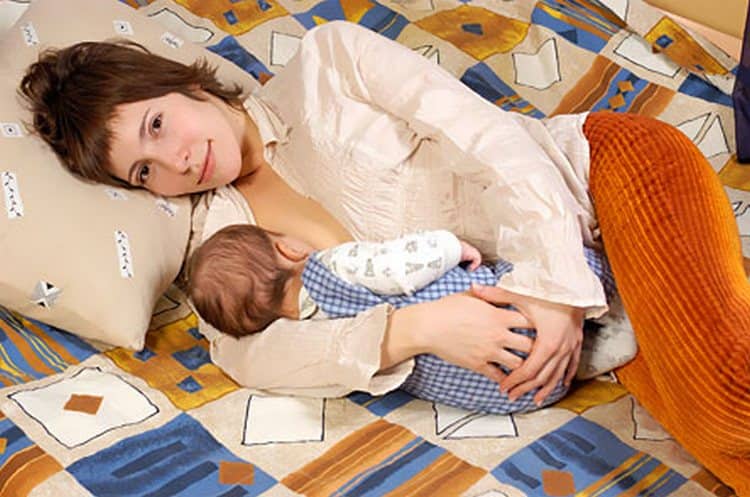
If the baby is exclusively breastfed, then it is too early to talk about introducing complementary foods (read more about the first complementary foods while breastfeeding). However, in some cases, when a baby is not gaining weight well while breastfed, the pediatrician may recommend starting to feed him dairy-free cereals as early as 5 months (read more about cereals for first feeding). In this case, it is optimal to give complementary foods during the second feeding - at 10:00. As for artificial babies, they, as a rule, begin to be fed from 4 months. That is why, by the age of 5 months, it is already possible for them to replace 2 feedings with complementary foods, say, at 10:00 (dairy-free porridge) and 14:00 (vegetable puree).

What toys are suitable for 5 month old babies?
Pediatricians recommend teethers made of rubber or silicone of different shapes and sizes, toys with a mirror surface, and a large fitball for five-month-old children. Toys consisting of a base on which small balls and objects are attached.
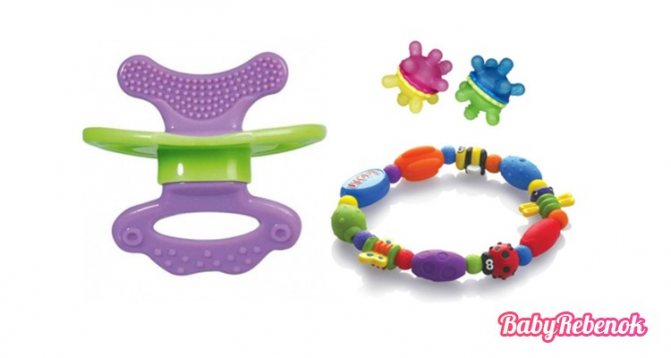
The materials used to make toys must have different surfaces: rough, hard, bumpy, sliding and soft spikes.
Toys for the development of five-month-old children must be safe and of high quality, because all babies taste them, and constant contact with chemical components can cause allergies or poisoning.
For the proper development of a five-month-old baby, you can purchase toys with a set of sound effects. The most beneficial ones will be:
- Soft toys with hard balls inserted inside, elements with foil, squeakers;
- Rattles with many colors and baby drums;
- Matryoshka dolls of bright colors that do not contain small parts;
- Finger pupae;
- Stuffed animals singing songs or telling poems;
- Children's musical instruments (metallophone, piano). Household items such as a saucepan with a lid, spoons, ladle, etc. are also suitable for this role.
Let's consider what all children at this age like.
"Tumbler"
At the age of five months, the child sits or masters this skill, the game will help him with this. The adult carefully places the baby on his back from a sitting position and calls him back to sit down. The child tries to take the starting position.
Body games
Raise the child by gently tossing him, then release him down and put him on his feet for a few seconds. In this case, you can tilt the baby forward so that he can walk a few steps. This game will help the child master the basic principles of walking and stimulate the vestibular system.
Football game
The baby lies on his back, an inflatable ball is placed under his legs so that the child can push him away. If the baby has already learned to sit, then you can throw a ball at him so that the baby fights with his hands, but you should be careful to avoid hitting him in the head.
Such exercises will help make your baby's muscles stronger and improve his coordination of movements.
"Bubble"
Growing children love to watch soap bubbles fly around the room. This interesting activity will delight them. If family members draw his attention to small bubbles, the baby will acquire an understanding of the size of objects.
Game of Peek-a-boo or Hide and Seek
Mom hides her face behind a scarf, or covers it with her hands and asks the baby: “Where is mommy?” After a few seconds, he pulls off the scarf (opens his hands) and shows himself to the baby. After this, he does the same with the child - he hides it behind a scarf, and then opens it, soon the baby himself will begin to pull off a piece of material.
All children enjoy games to varying degrees; it depends on their character traits, the development of the central nervous system and their mood. But all options are worth trying. Because they will help in the development of visual, auditory and speech skills.
Finger games
The easiest way to stimulate brain activity in a growing child is through various finger games: clenching fists, rubbing, bending; everything needs to be accompanied by jokes, poems and songs; they improve auditory perception and teach how to use pens. Let's look at the advantages of finger games:
- Fine motor skills exercises with verbal or musical accompaniment. They have a stimulating effect on the parts of the cerebral cortex responsible for speech. In the future, this will affect the child’s first words - they will appear faster.
- In a favorable and positive atmosphere, children listen to their parents more carefully, memorize words better, and they try to understand what family members are saying. Children also acquire imitation skills.
Such exercises affect the development of memory, because they demonstrate certainty of actions.
Acting in accordance with the recommendations of pediatricians, it is important for children of five months to choose finger exercises that they could repeat.
The beginning of the game is always a warm-up. It is needed to warm up the muscles and lift the mood. Warm-up consists of the following:
- Alternately bend and straighten your fingers, first each separately, then all together.
- Stroke your entire palm.
- Lightly stroke each finger, paying special attention to the joints. It looks like you are putting gloves on your hands. But it’s important not to overdo it—don’t squeeze your fingers too hard.
- Exercises “Open and close the gate”: you need to take the child’s hand and bend it left and right, squeezing the fist and scrolling it in the same direction.
The game itself has many techniques. But the main thing remains that all actions must be done while singing songs and reciting rhymes:
- Pulling each finger, try to stretch it, as it were. This should be done with your fingers spread out on the handle.
- Perform movements with each finger of the baby in different directions.
- Use additional items. Rattles, balls of various textures, and silicone balls are suitable for this purpose.
- Game "Comb your hair." Raise your child's arms as high as possible and run them over his head, straightening his hair.
Dream
The total daily sleep duration of a 5-month-old child is, on average, 16 hours: 10 of which, as a rule, occur at night, and 6 during the day. The optimal number of daytime sleeps at this age is 3-4 for 1.5-2 hours. At 5 months, the baby no longer interrupts his night sleep so often to eat, and some babies are already able to sleep for 10 hours straight without waking up to feed.

Night and daytime sleep of a five-month-old baby

When the baby is five months old, this is a long-awaited event for parents. From now on they will be able to sleep peacefully. Such babies are able to sleep all night without unexpected awakenings.
It is important that mom and dad provide the child with a daily sleep schedule. If the child sleeps too long during the day, he will wake up at night.
Pediatricians recommend providing your baby with a short rest during the day and evening walks. After lunch there should also be a quiet hour.
Wakefulness
At 5 months, the waking time between sleeps lasts, on average, about 2 hours. And in order to provide the baby with a full and sound sleep, it must be carried out as actively as possible. So, a child’s leisure time at this age may include:
- Fun with toys. The best toys for a 5-month-old baby will be: colorful rattles, musical and luminous toys, toy musical instruments, squeaky toys, toys with foil inserts, soft toys for finger theater, etc.
- Developmental activities. Once you reach 5 months, you can fully engage with your baby, for example: read books to him and look at pictures with him, do finger exercises (for example, rolling a pencil or walnut along the inside of your baby’s palm), sing songs, introduce him to various objects, calling them.
- Physical exercise. So, you can in every possible way develop your baby’s ability to crawl and roll over (if he doesn’t know how to do this yet), work out with him on a fitball, and even go to the pool with him.
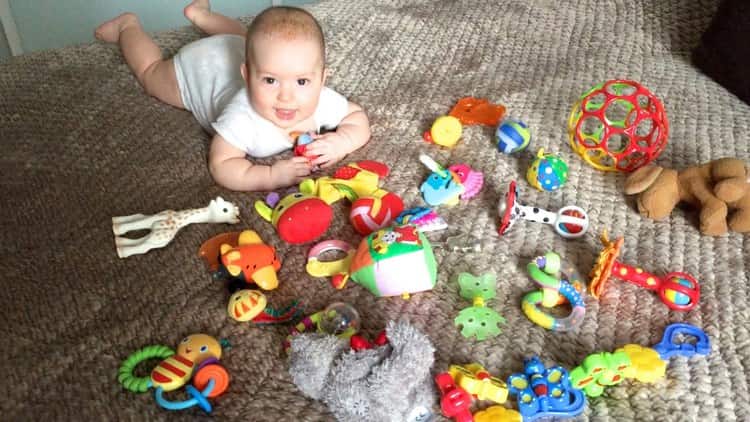
Communication and games
- Continue to develop your child’s tactile senses; it is useful for him to feel elements made from different textured materials.
- A child's hearing and thinking will help develop simple musical instruments, such as a drum, toys with buttons that, when pressed, begin to play pleasant melodies, a toy piano and a metallophone.
- Looking through a family photo album shortly before bedtime can be an excellent and calm entertainment for a child; the child is already quite capable of recognizing loved ones.
- For the development of speech, objects will be useful, the palpation of which will develop the infant’s fine motor skills. Give him small balls, thick pencils, and let him play with cereals.
- During the fifth month, many children begin to actively walk, your task is to create the appearance of a full-fledged dialogue with the baby, this will encourage him to try to pronounce sounds further and try to repeat sound combinations after you.
- Some kids may already be interested in other children on walks, looking at them in surprise. It will still be many months before babies are ready to interact with each other, but for now you can use other babies as a “teaching tool.” Explain to your child what other children are doing and comment on the events taking place: “the girl cried,” “the boy ran,” “the boy fell.”
Walks
Spending time in the fresh air is of great importance for the healthy development of the baby. As for the duration and number of walks in 5 months, it all depends on the time of year and weather conditions. In the warm season, it is recommended to walk with a five-month-old baby 2 times a day, morning and evening, for several hours. In winter, one walk a day lasting about 40 minutes is quite enough.

Hygiene procedures
Hygienic procedures must be included in the daily routine of a 5-month-old child; they include:
- morning hygiene (washing the face, eyes, cleaning the nose and ears, wiping folds);
- daily evening bathing, which should last at least 5-10 minutes in water at a temperature of 36 degrees;
- wet cleaning and ventilation of the room (at least 4 times a day) in which the baby is located throughout the day.
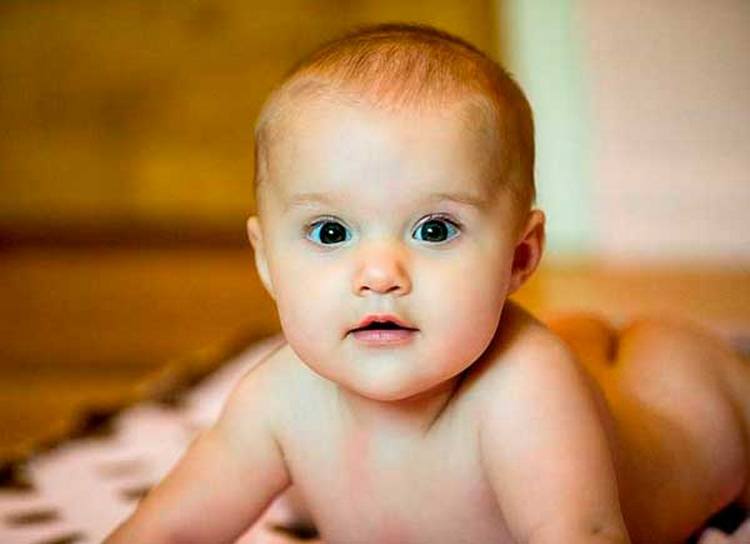
Hygiene of a 5 month old baby
The baby woke up, ate, is in a good mood and is awake - which means it’s time for hygiene procedures.
At five months, morning hygiene procedures remain mandatory:
- You can wash your face not with boiled water, but simply with warm water (room temperature). Do not use soap to wash your face, because the baby’s skin is still quite thin and delicate, it can become dry and begin to peel. There is also no need to use moisturizers daily.
- It is necessary to wash the eyes, since the child’s tears contain special enzymes that protect against infectious diseases that enter the body. Remnants of frozen mucus can be found in the morning in the corners of the eyes or on the eyelashes. In order to cause less discomfort to your baby, first soak the hard pieces with water, and then carefully remove them with a cotton pad soaked in water. Increased formation of mucus, and even more so pus, should alert the mother, as this may be the beginning of conjunctivitis. In this case, you will need to consult a doctor.
- Caring for your ears should begin by removing wax from the outer part with a cotton swab, without penetrating deep into the auricle. When bathing, make sure that there is not a lot of water entering the baby’s ears, because it can wash out the wax from the ears, which serves as a protection. In addition, the ingress of liquid can lead to undesirable consequences, such as inflammation or cause pain.
- Cotton buds soaked in oil will help clean the nose.
- The baby's mouth is very sensitive and is susceptible to developing thrush. Therefore, the mother must ensure that a white coating does not appear on the soft tissues in her mouth. It usually appears first on the gums, uvula and inner cheeks. Also moisturize your baby's lips using a good quality clarified oil.
Oral care may be added to your morning routine. If your baby has at least one tooth, clean it with a soft brush.
It is recommended to bathe your baby every day before bed for 20–30 minutes. The water temperature should vary from +30 to +37 degrees. The child no longer lies quietly in the bathtub; he can hit the water with his hands and push off from the bottom with his legs.
The child is increasingly interested in rubber ducks, plastic boats and wind-up toys. Take them with you to make swimming more interesting.
After bathing, a good hardening method would be to pour water on the baby 1 - 2 degrees cooler than the original.
At this age, the baby still cannot do without diapers. They need to be changed approximately every three hours, and with each change, thoroughly wash the butt. It is useful to arrange air baths: the baby remains naked for some time.
Violations of the daily routine in children at 5 months
The most common reasons for violation of the daily routine among five-month-old babies are:
- Teething. In this case, the child experiences pain that prevents him from sleeping. You can relieve the pain with the help of special cooling gels, tablets and other medications, as well as by giving your baby a teething toy to massage the gums.
- Introduction of complementary foods. Sometimes, due to the consumption of too much of a new product or a product that is “unsuitable” for the baby, he suffers from digestive problems and abdominal pain, which, in turn, disrupts eating and sleeping patterns.
- Excessive overstimulation. If the baby has been too busy and is too tired, this can lead to difficulty falling asleep and affects the quality of sleep.
- Malaise. Various diseases can also cause the baby’s daily routine to be significantly disrupted due to his poor health.

What can you feed your baby?
It is recommended to start introducing your baby to new foods with vegetable purees or dairy-free cereals. Previously, pediatricians advised giving applesauce as the first complementary food, but now the recommendations have changed, and experts in the field of baby nutrition advise starting the introduction of new foods into the diet with vegetables so that the child does not get used to sweet foods. Even fruit puree without sugar has a pleasant sweet taste, after which the baby may refuse to try unsalted and unsweetened vegetables.
The ideal product for first acquaintance is zucchini. It very rarely causes food allergies, contains a lot of mineral salts, replenishes the lack of fluid (which is especially important for bottle-fed babies) and has a sweetish taste that children really like. Gradually, you can add broccoli, potatoes, and cauliflower to your diet. At the beginning of the sixth month of life, the baby can also be offered vegetables and fruits that are brightly colored, for example:
- pumpkin;
- carrot;
- sweet bell pepper;
- peaches.
Apples, pears, prunes can be introduced into the menu from 4 months. Bananas are allowed for consumption from the age of five months, but if the baby is prone to digestive disorders and constipation, it is better to postpone their introduction until 6 months. Tomatoes and peas can be given to children no earlier than 7 months.
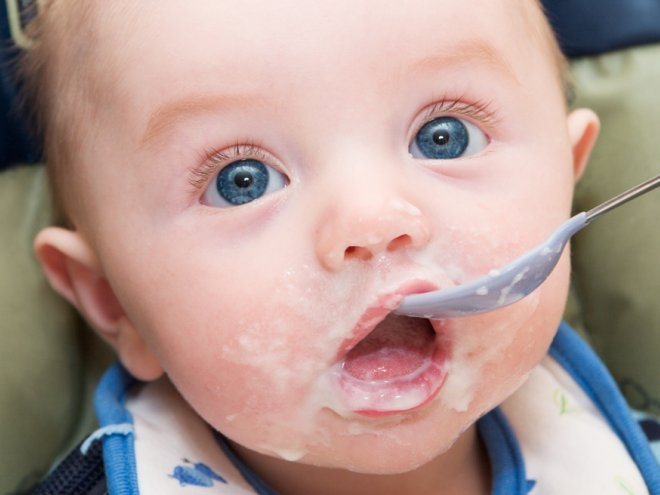
Pediatricians recommend giving buckwheat or oatmeal as the first cereals for complementary feeding - they have increased hypoallergenic properties, are well tolerated and contain all the minerals and vitamins (especially iron) necessary for the child's body. You can add fruit or vegetable puree and a little vegetable oil to the porridge. It is necessary to increase the daily amount of porridge in the baby’s diet to the recommended amount within 3-4 weeks. If the baby does not have digestive problems and he willingly eats porridge without milk, you can offer him milk porridge (no more than 20-30 g at a time).
Important! By the end of the sixth month of life, children who absorb milk sugar well can be given low-fat yogurt or cream. They are usually added in small quantities to fruit purees. Cottage cheese should be introduced into the menu no earlier than 6-8 months (the same applies to meat).
In native mode
Unsystematicity in the daily routine of a five-month-old baby is fraught with a lack of adequate sleep, excessive whims and irritability of the baby, lack of the desired contact between him and his mother, etc. So it is extremely important not to allow the child to build a schedule, taking into account his whims, but to take the situation into account your hands.

As has already been said, you should not impose on your baby the ideal concept of a daily routine that you spied on the Internet or from a neighbor, but you need to find the optimal version of the routine, based on the biological rhythms of your little one.







